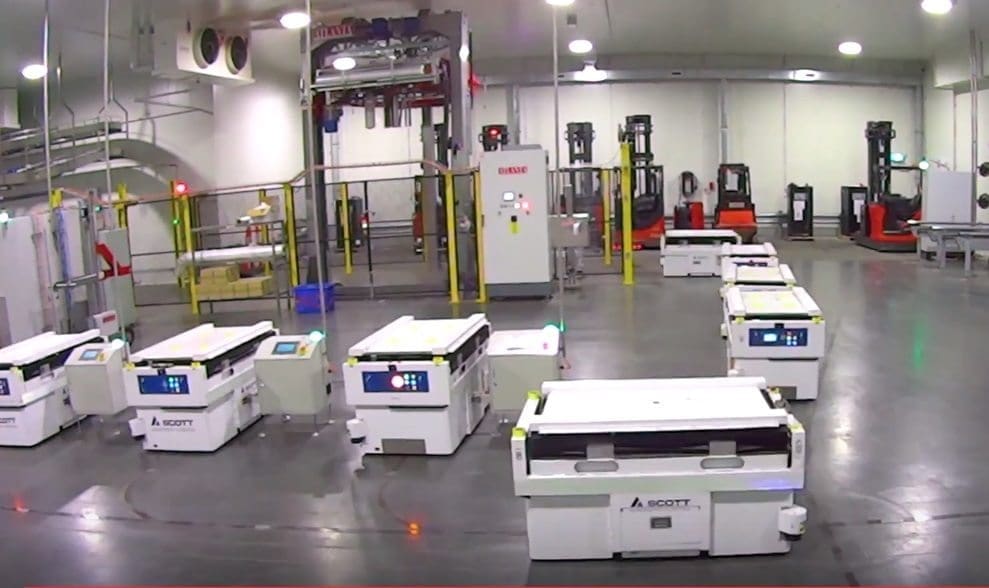THE application of robotics and automation in the red meat processing industry continues to gather pace, with the latest technology – automated guided vehicles – now installed and working in a Queensland meat plant.
Automated guided vehicles, or AGVs, join existing automation systems like centralised robotic palletising and robotic rib-cutting machines.
As this short video shows, an early installation of the AGVs has been made at Kilcoy Pastoral Co’s grainfed export beef plant north of Brisbane. Replacing conventional forklifts, they work in a similar fashion as self-guided road vehicles and driverless tractors, now beginning to emerge.
In the example seen in this video, a fleet of 12 AGVs collect completed pallet loads built by Kilcoy’s four large robotic palletising machines, get each load shrink-wrapped, checked against bar codes for accuracy, attach documentation, and transport each pallet of beef to the loading dock for transfer into a shipping container or refrigerated vehicle.
Scott Automation says its Automated Guided Vehicles can operate 24 hours a day, seven days a week, 365 days a year, meaning a constant flow of production on the work floor, and providing increased production, safety and plant efficiency.
The vehicles periodically return to docking stations to re-charge their electric batteries – all without human intervention.

Autonomous transport robots at work, and at re-charging stations at the Kilcoy Pastoral Co plant north of Brisbane
“Automated Guided Vehicles provide a cost effective automated materials handling solution to transport pallets, cartons and products throughout a warehouse or manufacturing facility,” Scott says.
“With the ability to be installed into an existing facility, AGV’s provide a safe, cost effective and reliable option.”
Click these links to view Beef Central’s earlier plant automation videos:
DEXA alternatives being examined by processors
Meanwhile, in other recent processing technology developments, Beef Central has become aware of investigations by some processors into alternatives to the much-discussed DEXA X-ray technology for yield assessment.
While every meatworks application is different, in some facilities, it’s been determined that the cost to install DEXA may be considerably higher than what was earlier anticipated – up to $3 million in one example discussed with Beef Central.
That inflated cost estimate is due to major changes that would be necessary to accommodate the system on-site, including shifting existing equipment, and the installation of lead-lined chambers and funnels to protect workers from exposure to the system’s X-ray radiation.
That potential cost over-run has sparked processor interest in alternate carcase yield assessment technologies. One of those is German company E&V Technology’s vision camera based systems, which potentially, could be far cheaper, easier and safer to install.
E&V produces two technologies – a rib-eye camera system for quality grading, already widely used in North America, and a second whole carcase yield-assessment camera system. E&V has held patents on video image analysis technology to determine carcase yield since 2001.
An important distinction between E&V’s camera-based vision system and DEXA, however, is that the E&V system is not compatible with robotics – it cannot deliver prescribed cutting lines for robots used for rib scribing of carcases, as DEXA can, for example.
The potential to align yield assessment with introduction of automated rib cutting was one of the key attractions seen with DEXA, under MLA’s roll-out model.
But for processors who for various reasons do not see the potential to hitch yield assessment systems to robotics, cheaper, easier alternatives like E&V’s system may be an answer.
One processor told Beef Central that E&V’s system in its current form was not as accurate in predicting yield as DEXA, which is said to be about 90pc accurate. But given that current manual yield prediction is only about 20pc accurate, any system offering 80pc or better accuracy may be more than adequate for industry purposes, Beef Central was told.
“It’s a matter of determining just how accurate a yield prediction system needs to be, to deliver value to industry,” one processor said.
Because the E&V technology is small and does not require elaborate shielding systems to protect against X-ray radiation leak in surrounding work areas, the cost and ease of installation is likely to be a considerable advantage, Beef Central was told.
An E&V system will be assessed under Australian processing conditions in coming months.
A web search suggests that E&V’s camera/software systems for yield prediction have been implemented as an ‘augmentation tool’ for manual grading in major Canadian beef plants.
“In North America, E+V Technology GmbH (VBG camera) and Research Management Systems, Inc (CVS beef Cam) are the main companies developing these camera/software systems,” one Canadian industry website said.
E&V itself claims to have graded up to 20 million beef carcases for yield, in Europe and Uruguay. Forty yield and quality grading machines are said to be in daily use, in applications analysing up to 450 carcases per hour. The technology relies on a series of cameras, using structured light and triangulation, to deliver 3D measurements of each carcase. More than 200 physical objective measurements are extracted from each carcase during assessment, used to calculate yield information. The technology uses a linear regression equation to calculate a yield prediction for each cut in a carcase, as well as overall carcase yield.
- Beef Central will seek more information once the E&V system has been assessed.
